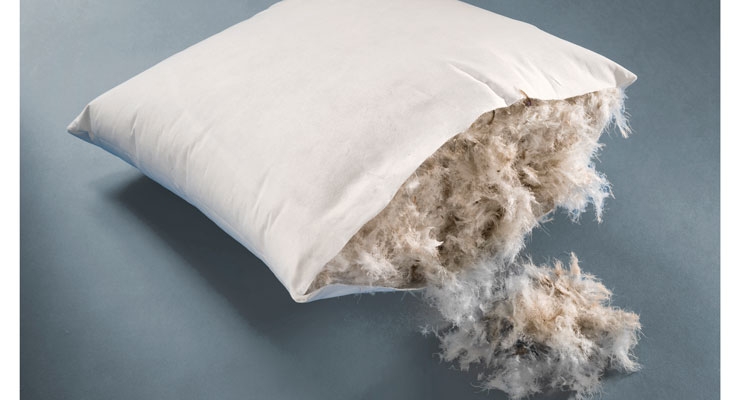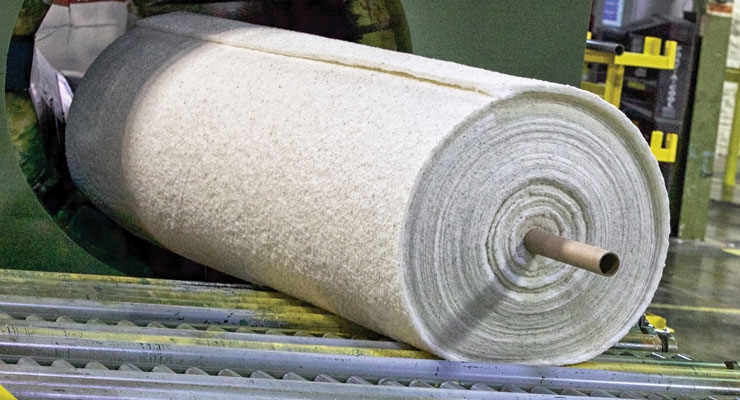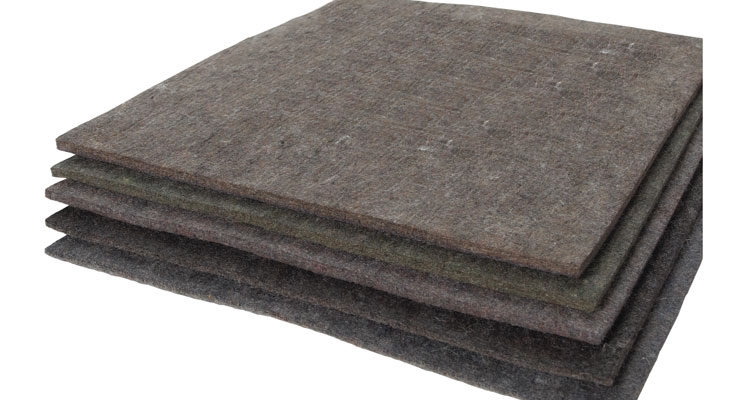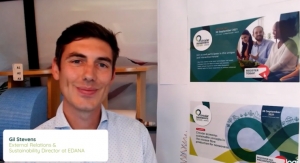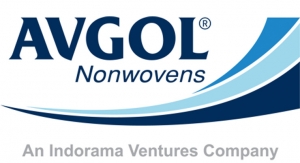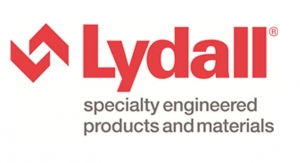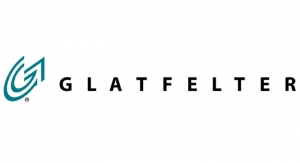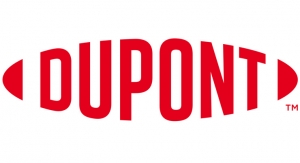Tara Olivo, Associate Editor03.27.17
Nonwovens are everywhere in the household. In the bedroom, nonwovens can be found in quilts, pillows and many parts of a mattress. In the living room, nonwovens might be underneath couch cushions or be providing shade in window treatments such as curtains in blinds. Nonwovens can be engineered to provide specific functions such as flame retardancy, absorbency, cushioning, stretch, strength, liquid repellence and so much more, and key players in the market continue to develop new solutions to make homes safer and more comfortable.
Bed Takeover
In bedding and mattresses, nonwovens show off their strength in the form of quilt backings, mattress coverings and spring protection, to name a few. They also can keep people safe by providing a flame retardant or flame resistant barrier fabric.
Adding to its Evolon range of microfilament textiles, Freudenberg Performance Materials recently launched super-microfilament textiles, an eco-friendly solution for pillows, duvets, sleeping bags and other quilted products filled with feathers and down.
Because the material’s structure features closely entangled super-microfilaments, which are up to 200 times thinner than a human hair and weigh less than 130gsm, super-microfilament textiles are ideal as high density cover fabric that prevents any loss of filling from even the finest layer of down. This version of Evolon can also mask dark feathers or those that are too thick and prickly.
Dr. Frank Heislitz, CTO, Freudenberg Performance Materials, says that the new Evolon variant offers perfect moisture management and high breathability, an effective barrier against dust particles and mite allergens without requiring chemical treatment, and its barrier properties remain durable, even after many washes. “[Freudenberg’s super-microfilament textiles] offer a high-quality, eco-friendly alternative to conventional fabrics and are the result of years of intensive R&D work conducted by Freudenberg experts,” he explains.
In mattresses and bedding, nonwovens producer Sandler’s sawaflor nonwovens are used as fillings for quilted mattress covers, mattress protectors and upholstered mattress covers, as well as fillings for bedspreads and quilts. In waterbeds, special nonwovens are applied to control the movement of the water filling, making these beds even more comfortable.
“Materials for mattresses and bedding provide for optimum temperature regulation, allowing the skin to breathe and thus helping to regulate moisture levels during sleep,” says Gerhard Klier, sales director Technical Products, Sandler. “The nonwovens combine optimum bulk with a high recovery rate, thus helping to prevent the formation of dents and creases.”
These thermally bonded nonwovens are made of 100% polyester fiber and offer a homogenous structure, recyclability and are washable.
Also supplying the mattress market is Jones Nonwovens of Humboldt, TN. The company produces thermally bonded cross-lapped nonwovens that create cushioning comfort layers for use in furniture and mattresses. Jones also manufactures insulating layers that separate the spring support system/unit from the cushioning layers. Fire barrier products that are used directly underneath the fabric or ticking are also made. These enable mattress manufacturers to comply with the federal open flame regulation that became a national standard in 2007.
The company, which runs three production facilities in Humboldt, TN, Morristown, TN, and North Las Vegas, NV, focuses on creating green, sustainable products.
“Jones Nonwovens has been a recycler long before recycling was a ‘thing,’” says Kenny Oliver, president of sales, Jones Nonwovens.
Jones uses a variety of post-industrial fiber from textile mills, garment manufacturers as well as byproduct fibers from the cotton ginning process, he points out. These fibers are primarily cotton, thus environmentally friendly and sustainable with a very small carbon footprint, and Jones has been able to engineer these fibers into an array of products.
“Performance attributes are excellent and cost is contained due to the very nature of recycled fibers,” he explains. “We also use many other virgin fibers that are sustainable and environmentally friendly—cotton, organic cotton, sisal, wool, kenaf, hemp and others. We are a LEAN manufacturer. This ensures that the marketplace can rely on our cost as being well controlled.”
Oliver says Jones’ design and development team continues to seek new opportunities in the market to meet the needs identified in their marketplace and in fact has discovered some major opportunities in some adjacent markets. As a result, the company plans to add production capacity, which it hopes to have online by early September.
Nonwovens Underfoot
A company specializing in nonwovens used in flooring is Shaw Industries, a Georgia-based manufacturer of carpet, hardwood, laminate, and tile and stone flooring products for residential and commercial markets. Shaw produces needlepunched nonwovens found in corporate/retail entryways in the form of backed mats, carpet tiles and broadloom carpets under the name Shaw Nonwovens.
“These entry carpets extend the life of interior floors, offer safety by reducing the incidences of slips and falls and decrease maintenance costs of the facility,” says Derek Bass, director of nonwoven business development, Shaw Industries.
Shaw Nonwovens’ materials are also sold as cushion pads for carpet and rugs and are offered as an attached performance backing, EcoLogix, on its modular carpet tile products. EcoLogix backing not only adds comfort under foot, but also provides for moisture vapor transmission when installed over concrete.
As Shaw grows beyond entryways and pads, it’s planning to launch several new products this year, with several trial installations underway this spring. “Our unique capabilities in color blend, layer composition, and structuring are yielding some fresh and innovative flooring alternatives,” Bass says.
Not only is Shaw growing its portfolio, the company recently invested $85 million to build a new carpet tile manufacturing facility in Adairsville, GA. Known as Shaw Plant T1, the facility, which became operational in the fourth quarter of 2016, provides added production capacity and recycling capability for the company’s Patcraft, Philadelphia Commercial and Shaw Contract brands.
Shaw invested in the new facility “to meet the needs of this growing market—today and into the future,” Bass explains.
Shaw had reached full capacity at its carpet tile manufacturing facility in Cartersville, GA, and its carpet tile manufacturing facility in Nantong, China, which opened in 2013, serves the Asia-Pacific market. In addition to the added capacity the new facility will provide, it will also allow the company to continue to innovate across its broad portfolio of products.
“We recognize that nonwovens technology not only opens up new possibilities in flooring styling, but also in our ability to create Cradle to Cradle designs that allow for products that are safe while in use and that have the opportunity to be reclaimed back into future flooring or other materials after use,” he says. “Our new flooring developments with nonwovens are being designed with consideration for this future reclamation.”
The Sound of Silence
Acoustic nonwovens are continuing to play a bigger role in dampening noise in homes and offices all over the world. Freudenberg’s SoundTex sound absorption materials make places like the office—the second home—more comfortable. SoundTex is a thin acoustic nonwoven that enables perforated structures to absorb sound. It can be used in a number of applications where acoustics are a prime consideration for either artistic or purely functional reasons. In addition to office buildings, partitions and furniture in offices, it can be found in airports, municipal halls, theaters, convention centers and subway stations.
Offering both economic and environmental advantages, according to Heislitz, sound energy is changed into thermal energy with a porous sound absorber such as SoundTex. Also, its ultrathin profile makes handling and installation easy. Further, via heat and pressure, the material is easily laminated onto all perforated elements directly at the factory, reducing shipping costs, workload and complexity at the construction site. “Its extreme thinness provides architects and designers with maximum flexibility while reducing shipping and storage costs at the same time,” he adds.
SoundTex’s textile structure and low weight make this acoustic nonwoven fabric significantly superior to other sound-absorbing materials such as mineral wool, according to Heislitz. “At the same time, SoundTex acoustic nonwovens cover a niche market, in which the product is very well established,” he says.
Sandler is also a specialist in this arena with its dimensionally stable, self-supporting nonwovens in the fibercomfort product line. Fibercomfort nonwovens are used as acoustically efficient room elements in suspended ceilings, partition walls or in textile wall decoration.
The thermally and mechanically bonded nonwovens are produced without chemical additives and are made of up to 70% recycled fibers, single-polymer, recyclable material. “Nonwovens for interior acoustics in offices contribute to optimum conversational acoustics in offices,” says Klier. “Their open-pore structure makes them efficient sound insulators. Open-plan office designs may be realized while also offering a quiet atmosphere conducive to concentration during work.”
The use of nonwovens in acoustic room elements for offices is a relatively new area of application, he explains, and new product designs are continuing to emerge here.
In fact, Sandler is making its home base more quiet by incorporating its nonwovens into an acoustic wall and ceiling concept for its new administration building in Schwarzenbach/Saale, Germany. “No doors are used on the individual floors,” he says. “A special arrangement of glass and acoustic partition walls separates individual workplaces and floor structures. The acoustic walls are lined with Sandler absorber nonwovens and provide a quiet working environment.”
Acting Shade-y
Lighter weight and lower cost are just some of the reasons the role of nonwovens continues to expand in window treatment applications. Other benefits include enhancing décor, offering insulation properties, stain resistance and light control, among others.
For its part, Bondex Inc., of Trenton, SC, produces thermally bonded nonwovens supplied for window sheers and shading applications.
According to Brian Little, senior vice president, sales and marketing, Bondex nonwovens offer superior uniformity as compared to competing technologies. For window blinds, the nonwoven is constantly visible to the end user like it is on a light box for a quality inspector, he says. Because of this, the market will not accept any foreign particles and defects in the product. So as a manufacturer of the nonwoven, Bondex is required to implement unique control features and detection technologies to produce efficiently against these quality requirements.
“However, defect free material is table stakes in this market,” Little says. “The value the product delivers is associated with the balance of light diffusion with basis weight. Product developers at the window treatment manufacturers manage a number of key variables to design natural light solutions for their customers in a way that is functional, decorative and artistic. Macro trends from consumers in the area of security, privacy and energy efficiency all support continued development in window shading solutions.”
An advantage of nonwovens over other materials used in these applications is that the materials can create beautiful effects based on the diffused natural light performance they deliver. “This effect is different than what is delivered with woven materials, or even blinds, which attempt light diffusion through a mechanical action of light diffusion between solid elements of wood or vinyl,” he says.
In window shading applications that incorporate nonwovens, Bondex’s customers aren’t just exploring new design features and geometries. In certain applications, nonwovens are replacing wovens as backing reinforcement in decorative window treatments. “This window treatment backing can provide a unique balance of properties with drape and texture which product designers enjoy to address changing consumer trends and styles,” Little explains.
Options Abound
For Turkish nonwovens producer Mogul, new Madaline microfilament textiles launched this year target many areas of the home, from bedding encasings and upholstery fabrics, to wallcovers and window treatments. “Madaline microfilament textiles provide the best combination of textile feel and touch and mechanical properties for a wide variety of home applications,” says Mogul CEO Serkan Gogus.
Madaline fabrics are ideal for interior design applications for their decorative, printability, sound absorption and sun protection properties. They can be processed using traditional textile manufacturing techniques; they’re able to be dyed, printed, finished, cut and sewn, just like any other fabrics. And, for bed and pillow encasings, Madaline inherently prevents penetration of dust mites and can be used for anti allergy bedding applications.
Madaline features state-of-the-art and patented bicomponent technology to extrude unique filament designs and then subjects them to high pressure water jets to simultaneously shear, fibrillate, entangle and consolidate microfilaments into a fabric. Its microfilaments are up to 100 times thinner than a human hair.
To Gogus, the possibilities for Madaline are endless. “Madaline microfilament technology is not only targeting functional applications in the home market but more value added fields like interior design and decoration, wellness, healthy bedding, wiping and drying solution for glasses and dishes,” he says.
Meanwhile, Italian spunbond producer RadiciGroup’s Dylar brand of nonwovens is used for home interior applications such as internal supports for sofas and chairs, in bedding as mattress ticking and spring pocket wrapping, and in disposable tablecloths for the Horeca sector (the European food service industry).
Available in various weights and a wide range of fadeless, bright colors, Dylar polypropylene spunbond nonwovens for tablecloth guards are manufactured using raw materials free of heavy metals or generally bioaccumulative substances, in full compliance with the European standard REACH EC 1907/2006. These products are also food contact protocol certified.
“Restaurants, nowadays, prefer to use these kind of nonwovens because they have a touch and feel as close as to textile cloth, respecting general hygienic conditions while reducing costs/time for the restaurant (no laundry costs, for example),” says Enrico Buriani, CEO of Tessiture Pietro Radici.
RadiciGroup will be expanding its capabilities in the tabletop market, as well as the other markets it serves, with a new spunbond line that is currently under construction. Expected to be complete by the end of this year, the line will offer a bicomponent technology process, allowing RadiciGroup to develop products with a wider range of technical features.
Bed Takeover
In bedding and mattresses, nonwovens show off their strength in the form of quilt backings, mattress coverings and spring protection, to name a few. They also can keep people safe by providing a flame retardant or flame resistant barrier fabric.
Adding to its Evolon range of microfilament textiles, Freudenberg Performance Materials recently launched super-microfilament textiles, an eco-friendly solution for pillows, duvets, sleeping bags and other quilted products filled with feathers and down.
Because the material’s structure features closely entangled super-microfilaments, which are up to 200 times thinner than a human hair and weigh less than 130gsm, super-microfilament textiles are ideal as high density cover fabric that prevents any loss of filling from even the finest layer of down. This version of Evolon can also mask dark feathers or those that are too thick and prickly.
Dr. Frank Heislitz, CTO, Freudenberg Performance Materials, says that the new Evolon variant offers perfect moisture management and high breathability, an effective barrier against dust particles and mite allergens without requiring chemical treatment, and its barrier properties remain durable, even after many washes. “[Freudenberg’s super-microfilament textiles] offer a high-quality, eco-friendly alternative to conventional fabrics and are the result of years of intensive R&D work conducted by Freudenberg experts,” he explains.
In mattresses and bedding, nonwovens producer Sandler’s sawaflor nonwovens are used as fillings for quilted mattress covers, mattress protectors and upholstered mattress covers, as well as fillings for bedspreads and quilts. In waterbeds, special nonwovens are applied to control the movement of the water filling, making these beds even more comfortable.
“Materials for mattresses and bedding provide for optimum temperature regulation, allowing the skin to breathe and thus helping to regulate moisture levels during sleep,” says Gerhard Klier, sales director Technical Products, Sandler. “The nonwovens combine optimum bulk with a high recovery rate, thus helping to prevent the formation of dents and creases.”
These thermally bonded nonwovens are made of 100% polyester fiber and offer a homogenous structure, recyclability and are washable.
Also supplying the mattress market is Jones Nonwovens of Humboldt, TN. The company produces thermally bonded cross-lapped nonwovens that create cushioning comfort layers for use in furniture and mattresses. Jones also manufactures insulating layers that separate the spring support system/unit from the cushioning layers. Fire barrier products that are used directly underneath the fabric or ticking are also made. These enable mattress manufacturers to comply with the federal open flame regulation that became a national standard in 2007.
The company, which runs three production facilities in Humboldt, TN, Morristown, TN, and North Las Vegas, NV, focuses on creating green, sustainable products.
“Jones Nonwovens has been a recycler long before recycling was a ‘thing,’” says Kenny Oliver, president of sales, Jones Nonwovens.
Jones uses a variety of post-industrial fiber from textile mills, garment manufacturers as well as byproduct fibers from the cotton ginning process, he points out. These fibers are primarily cotton, thus environmentally friendly and sustainable with a very small carbon footprint, and Jones has been able to engineer these fibers into an array of products.
“Performance attributes are excellent and cost is contained due to the very nature of recycled fibers,” he explains. “We also use many other virgin fibers that are sustainable and environmentally friendly—cotton, organic cotton, sisal, wool, kenaf, hemp and others. We are a LEAN manufacturer. This ensures that the marketplace can rely on our cost as being well controlled.”
Oliver says Jones’ design and development team continues to seek new opportunities in the market to meet the needs identified in their marketplace and in fact has discovered some major opportunities in some adjacent markets. As a result, the company plans to add production capacity, which it hopes to have online by early September.
Nonwovens Underfoot
A company specializing in nonwovens used in flooring is Shaw Industries, a Georgia-based manufacturer of carpet, hardwood, laminate, and tile and stone flooring products for residential and commercial markets. Shaw produces needlepunched nonwovens found in corporate/retail entryways in the form of backed mats, carpet tiles and broadloom carpets under the name Shaw Nonwovens.
“These entry carpets extend the life of interior floors, offer safety by reducing the incidences of slips and falls and decrease maintenance costs of the facility,” says Derek Bass, director of nonwoven business development, Shaw Industries.
Shaw Nonwovens’ materials are also sold as cushion pads for carpet and rugs and are offered as an attached performance backing, EcoLogix, on its modular carpet tile products. EcoLogix backing not only adds comfort under foot, but also provides for moisture vapor transmission when installed over concrete.
As Shaw grows beyond entryways and pads, it’s planning to launch several new products this year, with several trial installations underway this spring. “Our unique capabilities in color blend, layer composition, and structuring are yielding some fresh and innovative flooring alternatives,” Bass says.
Not only is Shaw growing its portfolio, the company recently invested $85 million to build a new carpet tile manufacturing facility in Adairsville, GA. Known as Shaw Plant T1, the facility, which became operational in the fourth quarter of 2016, provides added production capacity and recycling capability for the company’s Patcraft, Philadelphia Commercial and Shaw Contract brands.
Shaw invested in the new facility “to meet the needs of this growing market—today and into the future,” Bass explains.
Shaw had reached full capacity at its carpet tile manufacturing facility in Cartersville, GA, and its carpet tile manufacturing facility in Nantong, China, which opened in 2013, serves the Asia-Pacific market. In addition to the added capacity the new facility will provide, it will also allow the company to continue to innovate across its broad portfolio of products.
“We recognize that nonwovens technology not only opens up new possibilities in flooring styling, but also in our ability to create Cradle to Cradle designs that allow for products that are safe while in use and that have the opportunity to be reclaimed back into future flooring or other materials after use,” he says. “Our new flooring developments with nonwovens are being designed with consideration for this future reclamation.”
The Sound of Silence
Acoustic nonwovens are continuing to play a bigger role in dampening noise in homes and offices all over the world. Freudenberg’s SoundTex sound absorption materials make places like the office—the second home—more comfortable. SoundTex is a thin acoustic nonwoven that enables perforated structures to absorb sound. It can be used in a number of applications where acoustics are a prime consideration for either artistic or purely functional reasons. In addition to office buildings, partitions and furniture in offices, it can be found in airports, municipal halls, theaters, convention centers and subway stations.
Offering both economic and environmental advantages, according to Heislitz, sound energy is changed into thermal energy with a porous sound absorber such as SoundTex. Also, its ultrathin profile makes handling and installation easy. Further, via heat and pressure, the material is easily laminated onto all perforated elements directly at the factory, reducing shipping costs, workload and complexity at the construction site. “Its extreme thinness provides architects and designers with maximum flexibility while reducing shipping and storage costs at the same time,” he adds.
SoundTex’s textile structure and low weight make this acoustic nonwoven fabric significantly superior to other sound-absorbing materials such as mineral wool, according to Heislitz. “At the same time, SoundTex acoustic nonwovens cover a niche market, in which the product is very well established,” he says.
Sandler is also a specialist in this arena with its dimensionally stable, self-supporting nonwovens in the fibercomfort product line. Fibercomfort nonwovens are used as acoustically efficient room elements in suspended ceilings, partition walls or in textile wall decoration.
The thermally and mechanically bonded nonwovens are produced without chemical additives and are made of up to 70% recycled fibers, single-polymer, recyclable material. “Nonwovens for interior acoustics in offices contribute to optimum conversational acoustics in offices,” says Klier. “Their open-pore structure makes them efficient sound insulators. Open-plan office designs may be realized while also offering a quiet atmosphere conducive to concentration during work.”
The use of nonwovens in acoustic room elements for offices is a relatively new area of application, he explains, and new product designs are continuing to emerge here.
In fact, Sandler is making its home base more quiet by incorporating its nonwovens into an acoustic wall and ceiling concept for its new administration building in Schwarzenbach/Saale, Germany. “No doors are used on the individual floors,” he says. “A special arrangement of glass and acoustic partition walls separates individual workplaces and floor structures. The acoustic walls are lined with Sandler absorber nonwovens and provide a quiet working environment.”
Acting Shade-y
Lighter weight and lower cost are just some of the reasons the role of nonwovens continues to expand in window treatment applications. Other benefits include enhancing décor, offering insulation properties, stain resistance and light control, among others.
For its part, Bondex Inc., of Trenton, SC, produces thermally bonded nonwovens supplied for window sheers and shading applications.
According to Brian Little, senior vice president, sales and marketing, Bondex nonwovens offer superior uniformity as compared to competing technologies. For window blinds, the nonwoven is constantly visible to the end user like it is on a light box for a quality inspector, he says. Because of this, the market will not accept any foreign particles and defects in the product. So as a manufacturer of the nonwoven, Bondex is required to implement unique control features and detection technologies to produce efficiently against these quality requirements.
“However, defect free material is table stakes in this market,” Little says. “The value the product delivers is associated with the balance of light diffusion with basis weight. Product developers at the window treatment manufacturers manage a number of key variables to design natural light solutions for their customers in a way that is functional, decorative and artistic. Macro trends from consumers in the area of security, privacy and energy efficiency all support continued development in window shading solutions.”
An advantage of nonwovens over other materials used in these applications is that the materials can create beautiful effects based on the diffused natural light performance they deliver. “This effect is different than what is delivered with woven materials, or even blinds, which attempt light diffusion through a mechanical action of light diffusion between solid elements of wood or vinyl,” he says.
In window shading applications that incorporate nonwovens, Bondex’s customers aren’t just exploring new design features and geometries. In certain applications, nonwovens are replacing wovens as backing reinforcement in decorative window treatments. “This window treatment backing can provide a unique balance of properties with drape and texture which product designers enjoy to address changing consumer trends and styles,” Little explains.
Options Abound
For Turkish nonwovens producer Mogul, new Madaline microfilament textiles launched this year target many areas of the home, from bedding encasings and upholstery fabrics, to wallcovers and window treatments. “Madaline microfilament textiles provide the best combination of textile feel and touch and mechanical properties for a wide variety of home applications,” says Mogul CEO Serkan Gogus.
Madaline fabrics are ideal for interior design applications for their decorative, printability, sound absorption and sun protection properties. They can be processed using traditional textile manufacturing techniques; they’re able to be dyed, printed, finished, cut and sewn, just like any other fabrics. And, for bed and pillow encasings, Madaline inherently prevents penetration of dust mites and can be used for anti allergy bedding applications.
Madaline features state-of-the-art and patented bicomponent technology to extrude unique filament designs and then subjects them to high pressure water jets to simultaneously shear, fibrillate, entangle and consolidate microfilaments into a fabric. Its microfilaments are up to 100 times thinner than a human hair.
To Gogus, the possibilities for Madaline are endless. “Madaline microfilament technology is not only targeting functional applications in the home market but more value added fields like interior design and decoration, wellness, healthy bedding, wiping and drying solution for glasses and dishes,” he says.
Meanwhile, Italian spunbond producer RadiciGroup’s Dylar brand of nonwovens is used for home interior applications such as internal supports for sofas and chairs, in bedding as mattress ticking and spring pocket wrapping, and in disposable tablecloths for the Horeca sector (the European food service industry).
Available in various weights and a wide range of fadeless, bright colors, Dylar polypropylene spunbond nonwovens for tablecloth guards are manufactured using raw materials free of heavy metals or generally bioaccumulative substances, in full compliance with the European standard REACH EC 1907/2006. These products are also food contact protocol certified.
“Restaurants, nowadays, prefer to use these kind of nonwovens because they have a touch and feel as close as to textile cloth, respecting general hygienic conditions while reducing costs/time for the restaurant (no laundry costs, for example),” says Enrico Buriani, CEO of Tessiture Pietro Radici.
RadiciGroup will be expanding its capabilities in the tabletop market, as well as the other markets it serves, with a new spunbond line that is currently under construction. Expected to be complete by the end of this year, the line will offer a bicomponent technology process, allowing RadiciGroup to develop products with a wider range of technical features.

